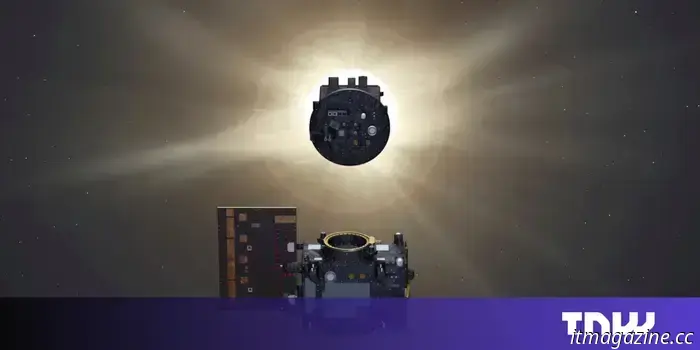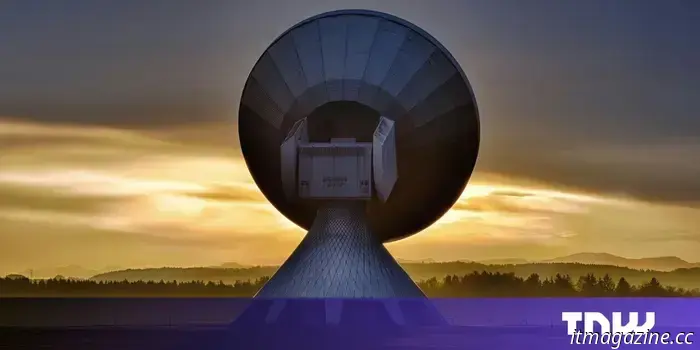
Engineered artificial solar eclipse in Europe provides fresh perspective on the Sun.
Two satellites equipped with European technology have successfully created an artificial solar eclipse, allowing scientists to observe the Sun's intense corona like never before. The European Space Agency (ESA) collaborated with over 40 space technology companies to develop these probes, including a trio of startups that provided essential technologies for the mission: solar tracking sensors, light detectors for precise positioning, and software that managed the satellites’ complex flight paths.
Launched from India’s Satish Dhawan Space Centre last year, the Proba-3 expedition may signal a new chapter in solar science. The image taken on May 23, 2025, by the ASPIICS coronagraph aboard Proba-3 shows the Sun’s inner corona, artificially colored dark green.
The two satellites orbit the Earth in formation, maintaining a distance of 150 meters from each other. One satellite, called Occulter, functions like the Moon during a solar eclipse on Earth, blocking the Sun's light so that its twin, the Coronagraph, can observe the Sun’s outer atmosphere or “corona” without interference from the bright light.
The Sun’s corona is the outermost layer of its atmosphere and is unexpectedly much hotter than the surface, occasionally reaching temperatures up to 2 million °C. This volatile area of superheated gases is responsible for solar storms and coronal mass ejections, which can interrupt telecommunications on Earth and create stunning Northern Lights displays.
The corona is usually visible only during a total solar eclipse, providing scientists with only a fleeting opportunity to study it. However, Proba-3’s success could change that.
As Andrei Zhukov from the Royal Observatory of Belgium, developer of the Coronagraph’s primary optical sensing instrument ASPIICS, noted, “We can generate our eclipse every 19.6-hour orbit, while natural total solar eclipses occur only about once a year, sometimes twice.”
While natural total eclipses last only a few minutes, Proba-3 can sustain its artificial eclipse for as long as 6 hours. Both satellites can stay perfectly aligned with one another and the Sun to within millimeter precision, all while orbiting Earth at a speed of 1 kilometer per second.
This accuracy is a result of the innovations from various European companies. Dutch startup Lens R&D, an ESA business incubator graduate, supplied sensors that continuously track the Sun’s position with extreme precision, enabling the intricate choreography of their formation flying.
Irish firm Onsemi (formerly SensL) contributed highly sensitive light detectors known as silicon photomultipliers, which detect minute changes in the Sun’s shadow across the satellites to adjust their positioning during the eclipse.
Additionally, software developed by Poland’s N7 Mobile, which transitioned from consumer applications to spacecraft control systems, aids in the probe’s formation control systems.
All these technologies are part of a European initiative to make a six-hour orbiting eclipse not only achievable but also reproducible.

Other articles
 Quantum art, multiball, and AI-generated selfies: The top side quests at TNW 2025.
From quantum-inspired art to mixed reality games and AI photo booths, the TNW Conference 2025 presents an astounding array of side events.
Quantum art, multiball, and AI-generated selfies: The top side quests at TNW 2025.
From quantum-inspired art to mixed reality games and AI photo booths, the TNW Conference 2025 presents an astounding array of side events.
 The most detailed observations of the Sun's south pole could reveal its secrets.
A spacecraft created by European scientists and companies has obtained unprecedented new observations of the Sun’s southern pole.
The most detailed observations of the Sun's south pole could reveal its secrets.
A spacecraft created by European scientists and companies has obtained unprecedented new observations of the Sun’s southern pole.
 European venture capitalists have placed a historic investment on this lesser-known fusion energy contender.
Only two years after coming out of stealth mode, German startup Proxima Fusion has secured Europe's largest private investment in fusion energy to date.
European venture capitalists have placed a historic investment on this lesser-known fusion energy contender.
Only two years after coming out of stealth mode, German startup Proxima Fusion has secured Europe's largest private investment in fusion energy to date.
 A guide for moving your startup to Valencia.
Valencia's expanding startup ecosystem presents European and non-European entrepreneurs with a new hub for innovation to develop and expand their businesses.
A guide for moving your startup to Valencia.
Valencia's expanding startup ecosystem presents European and non-European entrepreneurs with a new hub for innovation to develop and expand their businesses.
 7 TNW Conference sessions we’re looking forward to
The TNW Conference unites Europe’s brightest thinkers, most daring startups, and revolutionary technology in Amsterdam on June 19 and 20.
7 TNW Conference sessions we’re looking forward to
The TNW Conference unites Europe’s brightest thinkers, most daring startups, and revolutionary technology in Amsterdam on June 19 and 20.
 Opinion: Space startups are shifting their focus to defense. This is beneficial for innovation.
Space startups are transitioning towards defense, which is driving a fresh surge of advancements in deep tech, including optical communications and Earth observation.
Opinion: Space startups are shifting their focus to defense. This is beneficial for innovation.
Space startups are transitioning towards defense, which is driving a fresh surge of advancements in deep tech, including optical communications and Earth observation.
Engineered artificial solar eclipse in Europe provides fresh perspective on the Sun.
Two satellites have successfully created an artificial solar eclipse, allowing scientists to gain new insights into the Sun's outer atmosphere.
